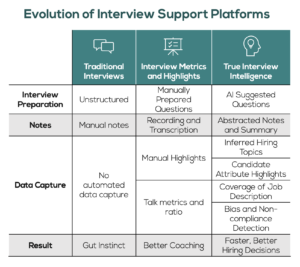Countless business functions—from customer service to sales and content marketing—are being improved through a mix of data, analytics, machine learning, and artificial intelligence. But a digital divide remains in one of the most critical organizational processes in human resources: interviewing.
Interviewing is still a primarily analog process, which makes hiring more subjective than it could or should be. In fact, HR teams report that 85% to 97% of hiring is based on gut instinct. That’s right, one of the most important and impactful processes in HR is still based primarily on instinct rather than data.
It’s no wonder that turnover rates are high and 60% of candidates report a poor interview experience. Turnover can be due to many factors but is often related to expectation setting and proper transparency during the interview itself. In a tight labor market like we’re facing today, startups and HR teams face massive challenges in filling open positions and can no longer afford to be hindered by ineffective analog interview processes. Gut instinct must be fact-checked with data.
Fact-checking Gut Instinct With Data
Gut instinct may always remain a reality of hiring, but what if we could augment instinct with objective data? Conversational analytics solutions now provide a way to automatically gather, synthesize, and present summarized, objective candidate data that helps recruiters and hiring managers compare their instinct with objective findings from the interview. Also referred to as conversational intelligence or conversational AI, these solutions extract data and insights from human-to-machine or human-to-human conversations.
A common use case for conversational analytics in human-to-machine interactions is leveraging chatbots to field customer service issues. The chatbot collects data to determine what the problem is and whether the customer is satisfied with the answers provided. In the area of human-to-human interaction, we’ve seen conversational analytics applied to the sales domain. Solutions such as Gong and Chorus listen to calls to extract “sales intelligence” to analyze the quality of opportunities.
Finally, we’ve arrived at the era of conversational analytics applied to HR, where solutions like HireLogic listen to job interviews and extract “interview intelligence” for a comprehensive understanding of candidates and what was covered during the interview.
How Conversational Analytics Radically Changes Interviewing
Conversational analytics provides interview intelligence automatically after an interview is completed. Some solutions in the market claim to provide interview intelligence, but instead, provide “interview metrics” like talk time and talk ratio, and allow users to manually highlight snippets of the transcript for review.
True interview intelligence goes beyond metrics to provide time-saving insights that help with hiring decisions. It detects the skills, job functions, industries, and titles discussed, reports how much of the conversation covered those topics, and flags portions of the transcript to surface candidate characteristics such as leadership qualities, aspirations, likes, and dislikes. This succinct analysis helps hiring managers understand how thorough an interview was, whether the interviewer’s recommendation is reliable, and what type of follow-up questions might be required.
To reduce bias and ensure compliance, interview intelligence flags potentially inappropriate questions around age, gender, marital status, or other personal traits so that employees can be coached on how to be better interviewers. For example, asking a candidate how old their children are may seem innocuous but could lead to age-related discrimination. Oftentimes, people don’t even realize they’re doing it, so it’s helpful to have AI attempt to detect and identify opportunities to improve interview compliance.
Having been a founder, a board member, and a C-Suite leader at several companies, I know how important interviewing is to find the right team member. Even the most seasoned manager can find it challenging to simultaneously think of the right questions to ask, listen carefully to the response, and take good notes that can be used for objective hiring decisions, all while trying to build rapport and engage with the candidate. When you compound this challenge across multiple team members, candidates, and positions, it quickly becomes apparent that having objective data to make informed hiring decisions helps tremendously to fact-check instincts and unconscious bias. Having used conversational intelligence to help gather this data automatically during calls, I never want to do another interview again without it.
Imagine the Data From 30 Million+ Interviews per Month
At the start of 2023, there were approximately 11 million job openings in the U.S. If you assume conservatively that there are three interviews conducted per opening, that’s over 30 million interviews a month, or roughly 1 million interviews happening every day in the U.S. alone. This is a significant amount of time and resources that organizations are spending to conduct interviews for hiring, and it’s still a mostly subjective process prone to unconscious bias.
If all that data could be instantly gathered and applied to augment the interview and hiring process, organizations may save countless hours, reduce unconscious bias, and experience less turnover. But most exciting above all is the prospect of helping both hiring managers and job seekers finally find the right fit for a productive and beneficial relationship.
Authors
Richard Mendis
Richard Mendis is the CMO at HireLogic. He has more than 20 years of experience in the tech industry and is using it to help companies hire smarter and faster.
Recruit Smarter
Weekly news and industry insights delivered straight to your inbox.





